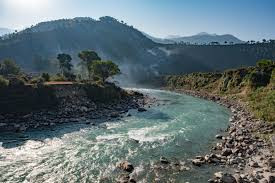Seti River: The Serene Flow Through the Heart of Nepal Professional
Nov 30th, 2023 at 10:10 Blogs Kathmandu 408 views Reference: 1174Location: Kathmandu
Price: Contact us
Seti River: The Serene Flow Through the Heart of Nepal
Introduction:
Flowing gracefully through the western landscapes of Nepal, the Seti River stands as a serene and captivating watercourse that weaves its way through valleys, offering both beauty and utility to the communities it touches. This article explores the geological origins, cultural connections, and environmental significance of the Seti River, celebrating its role as a vital part of Nepal's natural tapestry.
Geographical Origin and Course:
The Seti River originates high in the snow-capped peaks of the Annapurna Range, one of the iconic mountain ranges in the Himalayas. Fed by glacial meltwater and mountain streams, the river begins its journey through the rugged terrain of the western region of Nepal. The Seti's journey takes it through the picturesque Pokhara Valley, a popular destination for its stunning landscapes and serene lakes.
As it flows southward, the Seti River joins the Trishuli River before eventually becoming a tributary of the mighty Gandaki River. The river's course encompasses a variety of landscapes, from alpine meadows to subtropical forests, creating a diverse and ever-changing environment along its banks.
Cultural Connections:
The Seti River basin is home to various ethnic communities, each with its own cultural traditions and practices influenced by the river. The valley and surrounding areas are dotted with traditional settlements, ancient temples, and shrines, reflecting the deep connection between the local population and the Seti River.
Communities along the Seti rely on the river for agriculture, drawing water for irrigation to cultivate crops in the fertile valleys. The Seti's waters also play a role in shaping the cultural identity of the region, with ceremonies and rituals performed along its banks, emphasizing its significance in the daily lives of the people.
Scenic Beauty and Tourism:
The Seti River, with its clear waters and stunning landscapes, has become a popular destination for tourists seeking both adventure and tranquility. The river offers opportunities for rafting and kayaking, attracting adventure enthusiasts from around the world. The scenic beauty of the Seti Valley, framed by the Annapurna and Machapuchare mountains, adds to the allure, making it a sought-after destination for nature lovers.
Environmental Significance:
The Seti River basin is characterized by its ecological diversity, supporting a variety of flora and fauna. The river and its tributaries create habitats for diverse wildlife, including fish species, birds, and other animals. Conservation efforts are essential to preserve the environmental integrity of the Seti River, with initiatives focusing on sustainable development and habitat protection.
Challenges and Future Outlook:
As with many rivers, the Seti faces challenges such as pollution and habitat degradation due to human activities. Responsible environmental practices and community engagement are crucial to address these challenges and ensure the long-term health of the river and its surrounding ecosystems.
Conclusion:
The Seti River, with its origins in the pristine heights of the Annapurna Range, is more than a watercourse; it is a lifeline, a cultural anchor, and a source of natural beauty for the people of western Nepal. As efforts to conserve and protect the Seti River continue, it remains a testament to the delicate balance between human civilization and the environment. The Seti's journey, from the heights of the Himalayas to the valleys below, represents the interconnectedness of nature and humanity, inviting all to appreciate and cherish the serene flow through the heart of Nepal.


